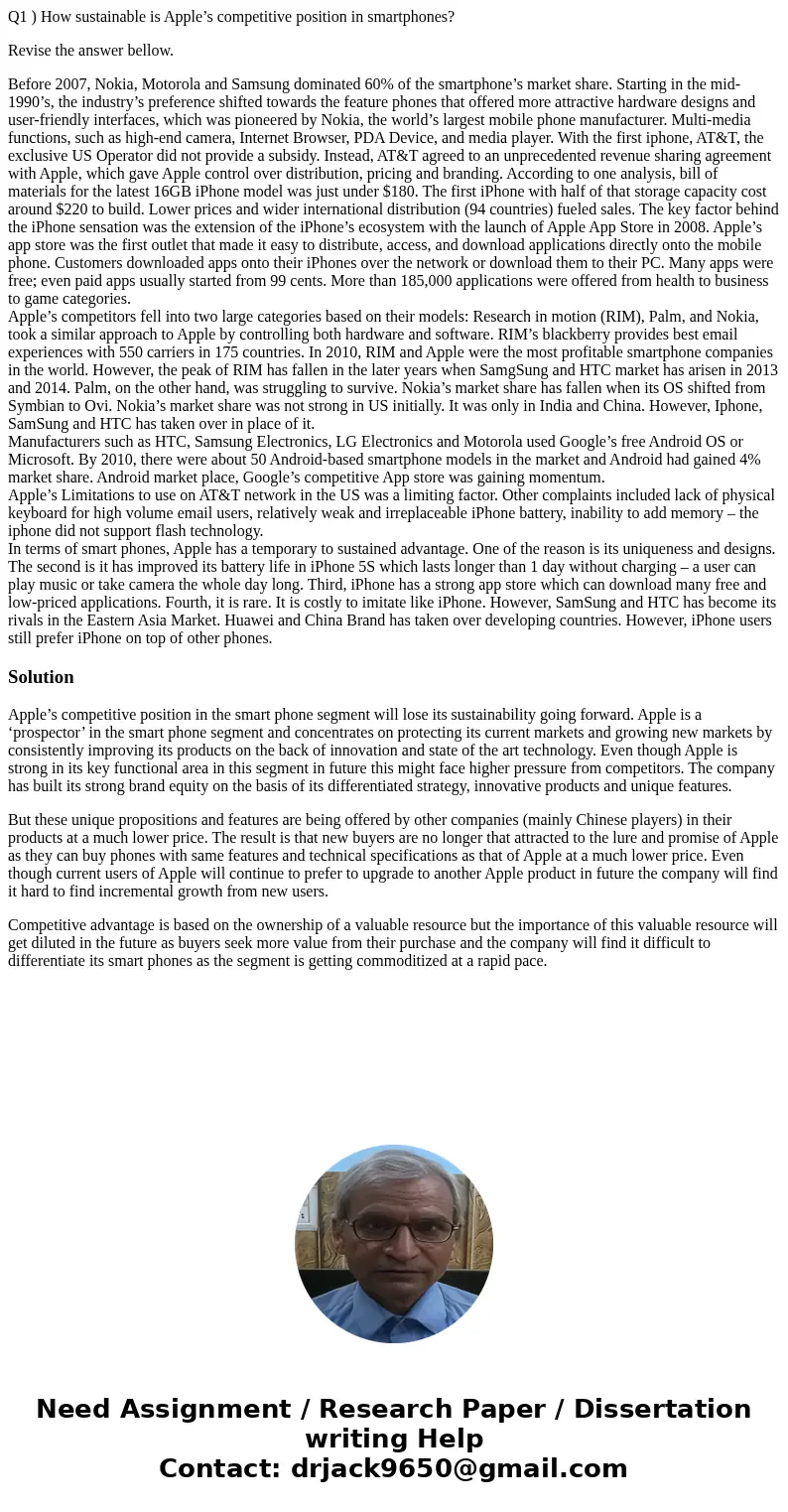Q1 How sustainable is Apples competitive position in smartp
Q1 ) How sustainable is Apple’s competitive position in smartphones?
Revise the answer bellow.
Before 2007, Nokia, Motorola and Samsung dominated 60% of the smartphone’s market share. Starting in the mid-1990’s, the industry’s preference shifted towards the feature phones that offered more attractive hardware designs and user-friendly interfaces, which was pioneered by Nokia, the world’s largest mobile phone manufacturer. Multi-media functions, such as high-end camera, Internet Browser, PDA Device, and media player. With the first iphone, AT&T, the exclusive US Operator did not provide a subsidy. Instead, AT&T agreed to an unprecedented revenue sharing agreement with Apple, which gave Apple control over distribution, pricing and branding. According to one analysis, bill of materials for the latest 16GB iPhone model was just under $180. The first iPhone with half of that storage capacity cost around $220 to build. Lower prices and wider international distribution (94 countries) fueled sales. The key factor behind the iPhone sensation was the extension of the iPhone’s ecosystem with the launch of Apple App Store in 2008. Apple’s app store was the first outlet that made it easy to distribute, access, and download applications directly onto the mobile phone. Customers downloaded apps onto their iPhones over the network or download them to their PC. Many apps were free; even paid apps usually started from 99 cents. More than 185,000 applications were offered from health to business to game categories.
Apple’s competitors fell into two large categories based on their models: Research in motion (RIM), Palm, and Nokia, took a similar approach to Apple by controlling both hardware and software. RIM’s blackberry provides best email experiences with 550 carriers in 175 countries. In 2010, RIM and Apple were the most profitable smartphone companies in the world. However, the peak of RIM has fallen in the later years when SamgSung and HTC market has arisen in 2013 and 2014. Palm, on the other hand, was struggling to survive. Nokia’s market share has fallen when its OS shifted from Symbian to Ovi. Nokia’s market share was not strong in US initially. It was only in India and China. However, Iphone, SamSung and HTC has taken over in place of it.
Manufacturers such as HTC, Samsung Electronics, LG Electronics and Motorola used Google’s free Android OS or Microsoft. By 2010, there were about 50 Android-based smartphone models in the market and Android had gained 4% market share. Android market place, Google’s competitive App store was gaining momentum.
Apple’s Limitations to use on AT&T network in the US was a limiting factor. Other complaints included lack of physical keyboard for high volume email users, relatively weak and irreplaceable iPhone battery, inability to add memory – the iphone did not support flash technology.
In terms of smart phones, Apple has a temporary to sustained advantage. One of the reason is its uniqueness and designs. The second is it has improved its battery life in iPhone 5S which lasts longer than 1 day without charging – a user can play music or take camera the whole day long. Third, iPhone has a strong app store which can download many free and low-priced applications. Fourth, it is rare. It is costly to imitate like iPhone. However, SamSung and HTC has become its rivals in the Eastern Asia Market. Huawei and China Brand has taken over developing countries. However, iPhone users still prefer iPhone on top of other phones.
Solution
Apple’s competitive position in the smart phone segment will lose its sustainability going forward. Apple is a ‘prospector’ in the smart phone segment and concentrates on protecting its current markets and growing new markets by consistently improving its products on the back of innovation and state of the art technology. Even though Apple is strong in its key functional area in this segment in future this might face higher pressure from competitors. The company has built its strong brand equity on the basis of its differentiated strategy, innovative products and unique features.
But these unique propositions and features are being offered by other companies (mainly Chinese players) in their products at a much lower price. The result is that new buyers are no longer that attracted to the lure and promise of Apple as they can buy phones with same features and technical specifications as that of Apple at a much lower price. Even though current users of Apple will continue to prefer to upgrade to another Apple product in future the company will find it hard to find incremental growth from new users.
Competitive advantage is based on the ownership of a valuable resource but the importance of this valuable resource will get diluted in the future as buyers seek more value from their purchase and the company will find it difficult to differentiate its smart phones as the segment is getting commoditized at a rapid pace.

 Homework Sourse
Homework Sourse